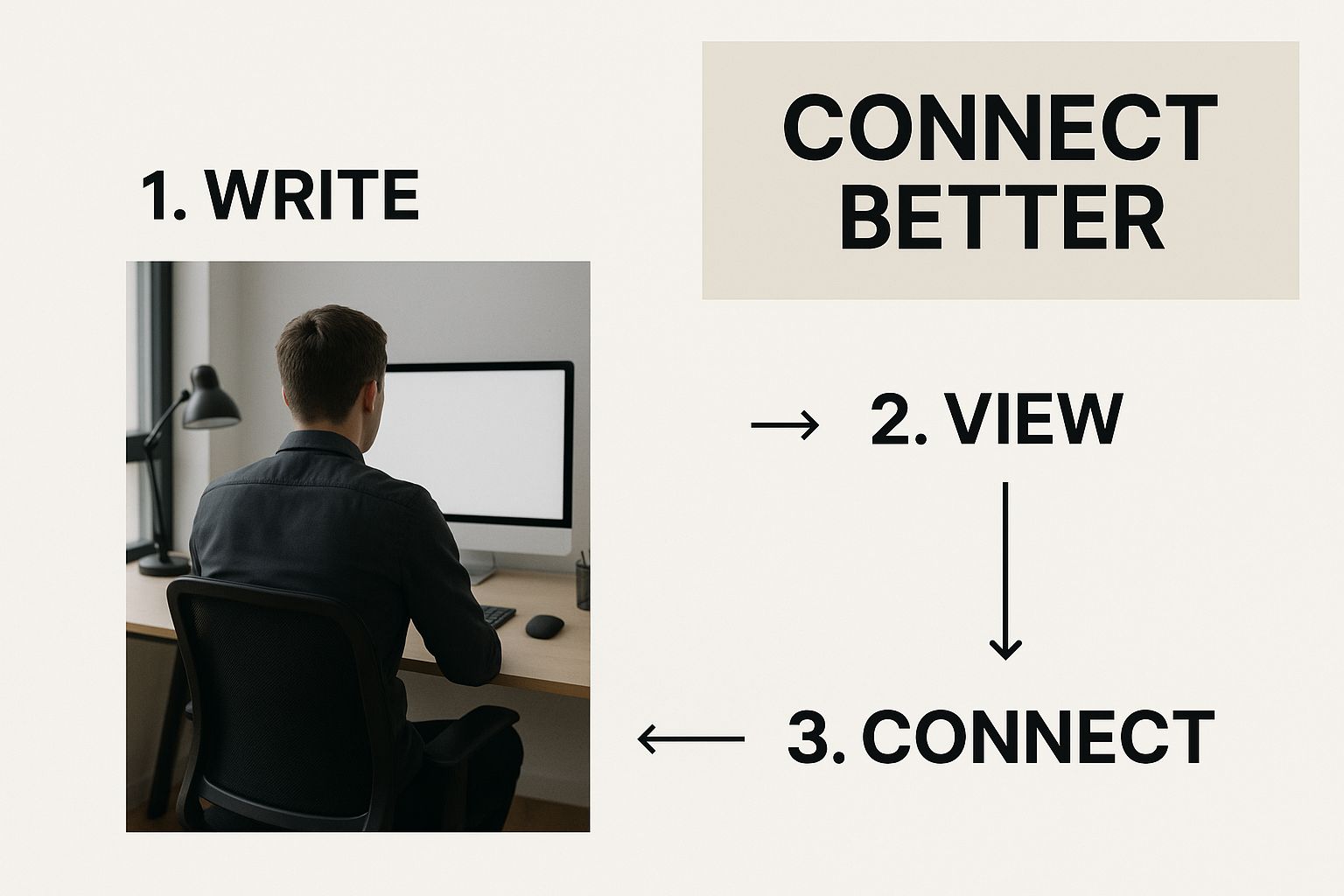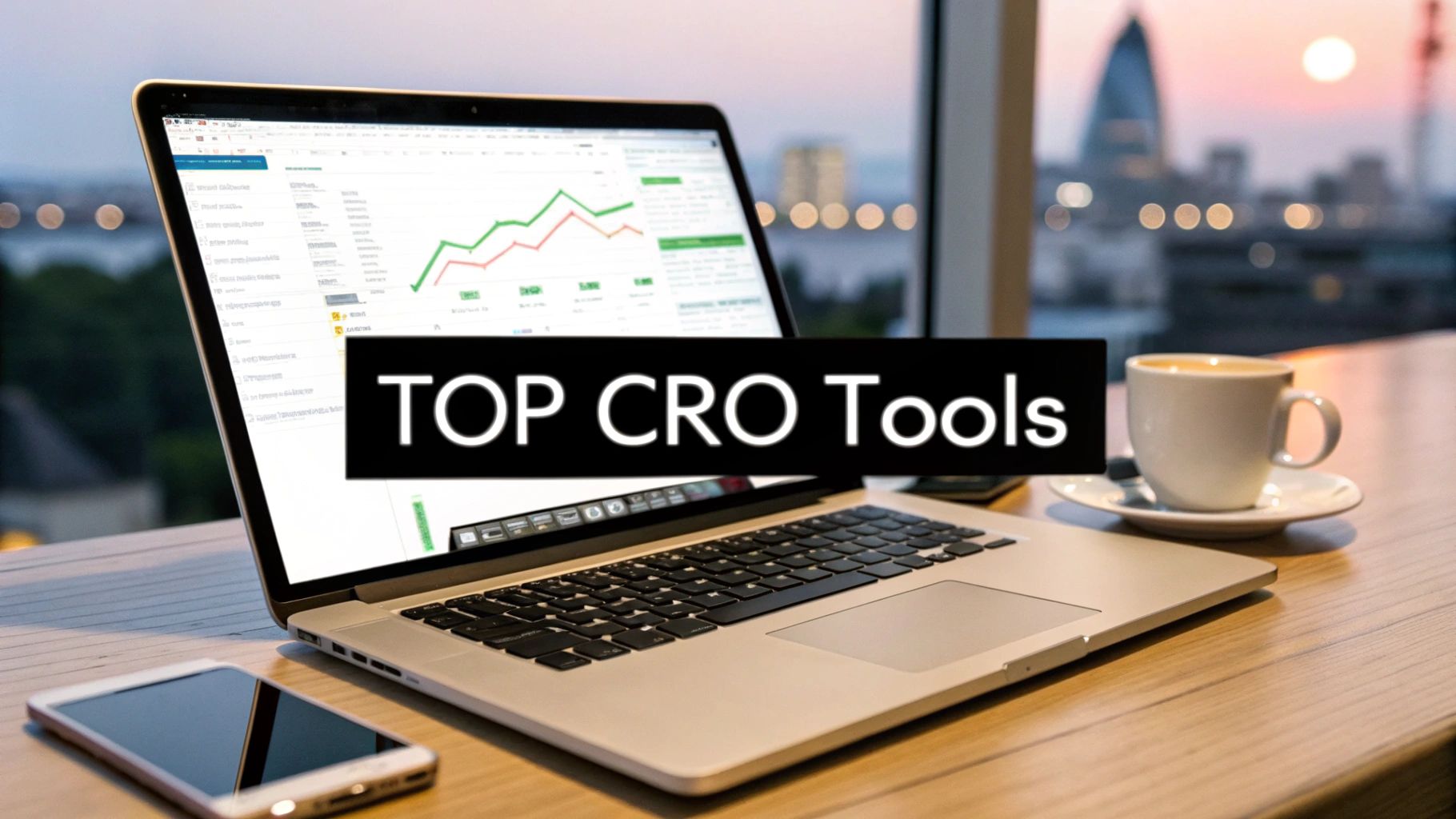
How to Write Website Content That Converts
0
5
0
Ever feel like you’re shouting into the digital void? You write, you publish, but your website traffic is flatlining and engagement is nowhere to be found. It’s a common, soul-crushing feeling for small business owners.
Here’s a secret: the problem probably isn’t your writing. It’s the lack of a plan. Too many people jump straight into writing, hoping a few fancy words will magically attract customers. That approach almost never works.
Content that misses the mark is usually created in a vacuum. It talks at people instead of to them. It lists a bunch of features but forgets to explain how they make someone’s life better. It drones on about company history without answering the one question every visitor has: “What’s in it for me?” How to write website content that converts.
Skipping the planning phase is like trying to build a house without a blueprint. You’ll end up with something wobbly and disconnected.

This is why you need a framework. A solid plan ensures every single page on your site has a job to do, guiding visitors from curiosity to conversion.
The Strategic Pillars of Powerful Content That Converts
Before you even think about opening a blank document, you need to nail down three core pillars. Get these right, and you're already ahead of the game. Get them wrong, and your content will feel generic and completely miss its target.
To get this right, you need to answer some foundational questions. I've laid them out here to give you a clear starting point.
The Strategic Foundation for Powerful Content
Strategic Pillar | Key Question to Answer | Impact on Your Content |
|---|---|---|
Audience Definition | Who am I really talking to? What are their biggest headaches and what words do they use to describe them? | Your tone, language, and examples will resonate deeply, making visitors feel understood. |
Core Message Clarity | What is the single most important idea I want visitors to walk away with? | Creates a consistent, memorable message that cuts through the noise and sticks in their mind. |
Tangible Goals | What specific action do I want someone to take on this page? (e.g., sign up, call, buy) | Dictates the entire structure, from the headline to the final call to action, making the next step obvious. |
Nailing down these pillars transforms your role from "writer" to "strategic communicator." It’s less about crafting the perfect sentence and more about solving a real problem for a real person.
The real secret to powerful website content is realising it's less about creative writing and more about strategic communication. Your primary job is to solve a problem for a specific person.
Don’t just take my word for it. The data shows that a strategic approach is essential. Heading into 2025, a massive 81% of marketers in the UK say content marketing is central to their strategy. Even more telling, companies that actually document their strategy see a 33% higher return on investment than those who just wing it.
At its core, this all comes down to effective copywriting for education—teaching your audience why your solution is the one they've been looking for. You’re building a bridge between what you offer and what they desperately need.
When you lay this groundwork, you stop just filling pages with text. You start engineering a journey that turns casual visitors into loyal customers.
Ready to build a content strategy that actually connects with your audience and gets results? Book a free consultation with Baslon Digital today, and let's turn your website into your most powerful marketing tool.
Writing for Your Audience, Not Yourself
Let's talk about the single biggest mistake I see businesses make with their website content. They go on and on about their company history, their fancy awards, and how great they are.
Here’s a hard truth: your customers don’t really care about you. They care about their own problems. Harsh, I know, but it’s the key to writing content that actually works.
You have to completely flip your perspective. Stop leading with what you do and start talking about what your reader needs. Every single sentence on your site should answer their unspoken question: "What's in it for me?"
For instance, a plumber's website shouldn't just state, "We offer expert plumbing services." Yawn. It needs to say, "Get your leaking pipe fixed today, with no hidden fees." See the difference? One is about the business; the other is about solving the customer's urgent, dripping-wet problem.
Uncovering Your Audience's Language
To really connect, you need to speak their language. That means getting inside their heads to understand their exact pain points, what they truly want, and the words they use to talk about it. Don't just guess—go find out.
This isn't as hard as it sounds. Here's where you can look:
Read customer reviews: Scour sites like Trustpilot or Google. The language people use in both glowing and furious reviews is pure gold.
Scan forums and social media: Dive into Reddit threads or Facebook groups where your ideal customers are hanging out and asking questions.
Interview past clients: Just have a chat. Ask them what was going on in their world that made them look for help in the first place.
Getting a crystal-clear picture of your audience is the foundation for writing content that doesn't just sit there, but actually resonates. If you want to dig deeper, our guide on how to determine who your online audience is walks you through the whole process.
From Features to Benefits
Once you know who you’re talking to, it's time to translate your services from features into benefits. A feature is what your service is or does. A benefit is what the customer gets out of it. People don't buy features; they buy a better version of themselves.
Let’s pretend you’re a Wix website designer based in London.
Feature (What you do) | Benefit (What they get) |
|---|---|
Custom Wix website design | A professional online shopfront that builds instant trust with new clients. |
SEO optimisation | Higher Google rankings, bringing more local customers right to your door. |
Mobile-responsive layouts | A perfect experience for visitors on any device, so you stop losing sales. |
This simple switch changes everything. You stop saying "look what we can do" and start saying "look what we can do for you."
A great trick is to keep asking "so what?" after every feature you list. Keep going until you hit an emotional outcome for the customer—more time, less stress, more money, or greater success.
This audience-first approach isn't just a clever writing trick; it's a core strategy. It shows you get it. You understand their world. That connection builds trust long before they ever pick up the phone, turning your website into a powerful relationship-building tool, not just a digital business card.
Ready to craft content that speaks directly to your ideal customer? Reach out to Baslon Digital today for a content strategy session.
Weaving SEO into Your Writing Naturally
Search engine optimisation, or SEO, sounds way more technical and intimidating than it really is. Let's forget the complicated algorithms for a second and boil it down.
SEO is just about making it easier for the right people—your ideal customers—to find your website when they’re searching for answers or solutions online.
It's absolutely not about cramming keywords into your sentences until your writing sounds like a confused robot. The real skill is writing for your reader first, while gently sending the right signals to search engines like Google.
Finding the Right Keywords
Before you can work keywords into your content, you actually have to find them. Your mission is to uncover the exact phrases your audience is typing into that search bar.
Put yourself in your ideal customer's shoes. Are they searching for a general "Wix designer in London," or are they getting more specific with something like "affordable website for a small bakery"?
You can unearth these gems with a few simple tricks:
Google Search is your best friend: Type a broad term related to your business into Google. Now, pay close attention to the "People also ask" box and the related searches at the bottom of the page. These are absolute goldmines for content ideas.
Listen to your customers: How do your clients describe their problems in emails, on phone calls, or in reviews? Their own words are often your most powerful keywords.
Spy on the competition (ethically!): Check out the websites of similar UK businesses that are ranking well. What topics are they covering? What words are they using in their main headlines and subheadings?
Focusing on longer, more specific phrases can be a game-changer. Learning how long-tail keywords help business owners can give you a serious advantage in attracting clients who are ready to buy.
Placing Keywords Authentically
Once you've got a list of good terms, the next part is weaving them in naturally. Don't force it. Your number one priority should always be creating clear, helpful content that’s a breeze to read.
The best SEO writing doesn't feel like SEO writing at all. It feels like a helpful, well-written article that just so happens to answer the exact question you were asking.
For freelance writers here in the UK, getting this balance right is crucial. Data from 2024 shows digital marketing is the top niche for UK freelancers. With a whopping 70% of marketers using website traffic to measure success, writing content that people can actually find is more valuable than ever. You can read more about the trends shaping freelance writing in the UK.
Strategic placement is where the magic happens. Try to include your main keyword in these key spots:
Your H1 Title: This is the main headline of your page.
The First 100 Words: Let readers and Google know what the page is about right away.
One or Two Subheadings (H2s or H3s): This helps break up the text and shows what each section covers.
Throughout the Body Copy: Sprinkle it in a few times where it feels natural and makes sense.
When you focus on writing for your audience first while subtly guiding the search engines, you create content that gets discovered and is genuinely useful.
Ready to improve your website's visibility and bring in more customers? Contact Baslon Digital for a professional SEO and content review today.
Designing Content for Readability and Impact
Let's be honest. Even the most brilliant, life-changing content will fall flat if it’s just a massive wall of text. How you arrange your words on the page is every bit as crucial as the words themselves. People don't read online; they scan. They hunt for keywords and headings to find what they need, fast.
Your job is to make that hunt effortless. The goal isn't just to write well, but to design an inviting reading experience that pulls your visitor's eye down the page. It's all about using visual structure to your advantage.
Strategic formatting is your best friend here. It’s what turns a dense, intimidating article into a scannable, digestible resource. Think of it as breaking up your content into bite-sized, manageable chunks that are easy to swallow.
Building a Scannable Structure
The whole game is about clear hierarchy and visual breaks. Without them, you'll lose your reader's attention in a heartbeat. Great structure isn't something you tack on at the end; it's a fundamental part of writing website content that actually works.
So, how do you create a layout that keeps people glued to the page?
Use Clear Headings: Subheadings (like this one!) are your signposts. They break up long sections and tell the reader exactly what's coming next, letting them skip to the bits that matter most to them.
Keep Paragraphs Short: Seriously, stick to a maximum of three sentences per paragraph. This creates essential white space, making the text feel less crowded and so much easier to process on a screen.
Leverage Bullet Points: Is there a better way to break down complex ideas, list benefits, or outline steps? I don't think so. Lists are magnets for the eyes and make key information instantly scannable.
But don't stop there. You can elevate your content's visual appeal even further. Use bold text to make key statistics or takeaways pop. A well-placed image or diagram can often explain a concept far better than several paragraphs ever could.
Think of your page layout as a conversation. Every heading, every bullet point, and every bit of white space is a tool to keep the dialogue flowing. It stops them from getting bored and clicking that dreaded back button.
This focus on visual clarity isn't just a nice-to-have; it's a cornerstone of modern web design. In fact, many of these principles line up with the 10 user experience design best practices for 2025, which all boil down to making digital interactions as intuitive as possible. And if you're looking for broader inspiration, these general design tips for creatives can offer some fresh perspectives. By marrying thoughtful writing with smart design, you create something far more powerful.
Ready to design website content that not only informs but also captivates? Schedule a free consultation with Baslon Digital, and let's create a visually compelling experience for your visitors.
Right, you’ve hammered out the first draft. High-five yourself, because that’s a massive step. But whatever you do, don't even think about hitting that publish button just yet.
Think of your first draft as a rough sketch. The basic shapes are there, but it’s messy and needs a lot of work before it’s ready for the gallery wall. This next part isn’t about writing more; it’s about refining, sharpening, and making every single word count. It’s what separates a forgettable blog post from a piece of content that actually does its job.
Your Secret Weapon: Read It Out Loud
Before you get bogged down in commas and spelling, do this one simple thing: read your entire draft out loud. Yes, you might feel a bit silly talking to yourself, but trust me, it’s a game-changer. Your eyes will glide right over clunky sentences that your ears will catch immediately.
When you force yourself to speak the words, you’ll instantly spot the awkward bits:
Clunky Sentences: If you find yourself running out of breath trying to finish a sentence, it's too long. Chop it up.
Annoying Repetition: Hearing the same word three times in one paragraph is far more jarring than just seeing it on the screen.
Robotic Tone: Does it actually sound like a human wrote this? Reading it aloud helps you find the parts that sound stiff, overly formal, or just plain weird.
The Essential Editing Checklist
Okay, now that it sounds better, it's time to make it read better. A spell-checker is a good start, but it won’t catch everything. Run through this quick checklist.
Is it clear and to the point? Hunt down any fluffy words, jargon, or sentences that ramble on. If you can say something with fewer words, do it.
Is everything consistent? Make sure your tone, formatting, and overall message don't suddenly change direction halfway through.
Grammar and spelling check (for real this time). Now’s the time for that final, eagle-eyed proofread to zap any sneaky typos.
Is your Call to Action (CTA) obvious? Does your final instruction make sense? Is it compelling enough for someone to actually click?
Polishing your writing isn't just about fixing typos. It’s about making your message stronger. A clean, well-edited article builds trust and shows your audience you actually care.
Don't Just Publish—Promote!
Here’s a truth bomb: you can write the most amazing article in the world, but if no one sees it, it’s completely useless. Your job isn’t finished when you hit publish. That’s when the real work begins.
So many businesses pour hours into creating great content only to let it gather digital dust. The stats are pretty grim. An incredible 94% of blog posts never get a single backlink from another website. That’s a huge problem because backlinks are a major signal to Google that your content is valuable. You can dive deeper into these sobering content marketing statistics yourself. It’s a stark reminder that you have to actively push your content out there.
Getting the word out doesn’t have to be complicated. A few simple steps can make a world of difference:
Share it across all your business's social media accounts.
Pop a link to it in your next email newsletter.
Find other relevant pages on your own website and link back to your new post.
Ready to create content that not only shines but also gets seen by the people who matter? Contact Baslon Digital today for a content strategy review.
Right then, where do you go from here?
You've got the playbook. You know how to take your website content from just words on a page to a proper, hard-working asset for your business. The real trick is to stop reading about writing content and actually get on with it.
Don't try to boil the ocean. Pick one page—just one. Make it an important one, like your homepage or that main service page everyone lands on. Give it a quick once-over using what you've learned here.
A high-performing website isn't born overnight from some massive overhaul. It's built piece by piece, with small, consistent tweaks. One thoughtful change today is worth more than a dozen grand plans for next month.
Find just one thing you can improve right now. Is it clear who you're talking to? Could you make it easier to read? Maybe your call to action is a bit… limp? Zero in on that one thing and fix it. Today.
It's these little, consistent updates that build momentum. That’s how you create a website that actually connects with people and, over time, drives real growth. Your content isn't a static document you write once and forget; it's a living, breathing part of your business. Treat it that way, and you'll start seeing the results you’re after.
Ready to see what properly crafted content can do for your business? Let's have a chat about a content strategy that will get your Wix site working for you.
Got Questions About Website Content? We’ve Got Answers.
Even with a solid plan, a few head-scratchers are bound to pop up when you're figuring out how to write for your website. It happens to everyone.
Think of this as your quick-fire guide for those moments when you're staring at the screen, not quite sure what to do next. Here are the questions we hear most often from small business owners just like you.
How Often Should I Actually Update My Website Content?
Forget what you’ve heard about a magic number. The simple truth? Consistency beats frequency, every single time.
For your core pages—the big ones like your Homepage, About Us, or Services pages—give them a once-over every six to twelve months. It’s a bit like a digital spring clean. You're just making sure everything from your pricing to your team photos is still accurate.
Now, for your blog, it's all about rhythm. A regular schedule is what gets you noticed by your audience and by search engines. Whether you can commit to once a week, once a fortnight, or once a month doesn't matter as much as picking a pace you can actually stick with.
The best content schedule is the one that doesn't lead to burnout. A blog that gets a great new post every month is way more valuable than one that starts with a flurry of weekly posts and then goes completely silent for six months.
What’s the Difference Between Website Content and a Blog Post, Anyway?
It helps to think of it like this: your main website content is the foundation of your house. It’s permanent. Pages like your Homepage, Services, and Contact page are there to tell people who you are, what you do, and how they can hire you. Their main job is to inform and convert.
A blog post? That's the conversation happening in the living room. It's dynamic, timely, and part of an ongoing chat with your audience.
Here’s a simple way to break it down:
Main Website Content: This is the static, foundational stuff about your business. Its goal is to build trust and drive action (like making a sale or booking a call).
Blog Content: This is the fresh, educational, and often entertaining stuff that reels in new visitors. Its goal is to show you're an expert, boost your SEO, and build a community.
Can I Just Use AI to Write My Website Content?
Look, AI can be a brilliant assistant, but it should never, ever be the author. Think of it as a tool, not a replacement for your brain and your experience. Use it to brainstorm ideas, bash out a rough first draft, or get you unstuck when you have a nasty case of writer's block.
But your oversight is non-negotiable.
An AI can't possibly capture your unique brand voice. It can't share that funny story about a client project from last year, and it can't show the genuine empathy that makes a reader feel truly connected. Always, always review, fact-check, and heavily rewrite anything an AI gives you. Make it sound like you.
How Do I Write a Call to Action That Actually Works?
A powerful Call to Action (CTA) isn't shy. It needs to be crystal clear, short, and punchy. Its entire purpose is to take the guesswork out of it for your visitor, making their next step completely obvious.
Start with a strong verb like "Get," "Download," or "Book." Then, add a little sprinkle of value or urgency. For instance, "Get Your Free Quote Today" is miles better than a boring old "Submit."
And finally, for goodness' sake, make it stand out. A CTA should almost always be a button, designed in a way that’s impossible to ignore.
Ready to stop guessing and start creating content that actually grows your business? The team at Baslon Digital lives and breathes this stuff. We specialise in crafting content strategies for Wix websites that get real, tangible results. Schedule your free consultation today, and let's turn your website into your hardest-working employee.


